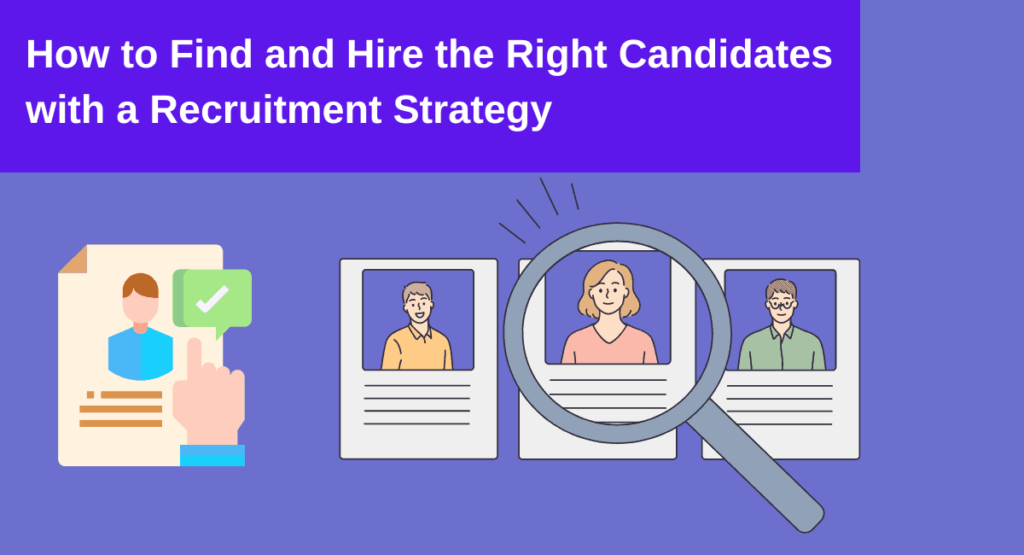How to Find and Hire the Right Talent with a Recruitment Strategy


Looking to hire new talent for your team but need help figuring out how to go about it?
A robust recruitment strategy is crucial in finding and securing the right fit for your organization.
You can ensure that the recruiting process is smooth and successful from start to finish.
The article comprehensively guides finding and hiring talent with a recruitment strategy.
Overview of the hiring process
“The unspoken secret of a successful recruitment strategy: building a pipeline of passive talent.” Vikram Ahuja.
A recruitment strategy is essential to any successful hiring process. It involves setting goals, creating recruitment plans, and developing recruitment methods.
The hiring process is to begin actively sourcing and screening potential candidates. Starting with advertising roles and handling all incoming resumes. List the best candidates, then conduct initial interviews in person or over the phone. They ultimately determine who best fits the role based on qualifications and character.
The final phase of the recruitment process is when a job offer is made and accepted by the candidate. This marks the official start date of their employment with your organization.
Importance of recruiting strategies

Recruiting strategies are essential to an organization’s success. They shape how a company attracts, hires, and retains talent.
It can be easier for a business to locate the best-qualified professionals and create an effective team. Companies need recruitment strategies to identify the necessary skills for specific positions. It should attract talented candidates who fit the organization well.
Recruitment strategies ensure that the right people with the right capabilities are always on board. The rewards of proper recruitment can be tremendous:
- Leading to higher productivity
- Better customer service
- Improved employee satisfaction
- Financial gains.
Recruitment strategies should contribute to achieving a company’s overall objectives.
Recruitment strategies are critical to finding top talent and managing recruitment cycles effectively.
The effective recruitment strategies
An effective recruiting strategy uses technology to help find and hire the right people for the job. Technology can make it easier to:
- Search for potential candidates
- Compare different skills and qualifications
- Contact them if they are a good fit.
Technology can also help automate recruitment processes, saving time and reducing administrative work.
A recruiting strategy should also consider the company’s recruitment goals and needs. A company knows the type of talent needed to meet business objectives. They know how to attract the right people for those roles.
An effective recruiting strategy must include the following:
- A clear plan for onboarding new employees
- Providing new employees with the appropriate training
- Provide resources new employees need to be successful in their roles.
- Ensuring new employees receive a warm welcome
- Understand their job responsibilities
- New employees have all the tools they need to do their jobs well.
Finally, recruitment strategies should also include plans for evaluating existing recruitment processes. If necessary, make any changes.
Get more out of your business
Get the best employee engagement content every week via mailing list
Assessing Your Needs & Goals

Assessing your needs and goals is a critical step in determining the path forward for any organization.
Using this opportunity to evaluate the current strengths and weaknesses within the existing team. And gauging how well they align with the existing company culture is essential.
An accurate assessment will help identify areas where additional resources may be necessary. The assessment lets you decide how best to reach desired targets and objectives.
Identifying skills needed for open roles
Understanding the skills needed for job roles and being able to identify them can be a crucial part of the recruitment process. Job descriptions are an important place to start when outlining a job role; they should be clear and concise and provide an accurate overview of what is expected and what company may require qualifications or specializations.
With job descriptions and employer expectations, you can look at job adverts, successful candidates’ CVs, job boards, and more to review the necessary skills specific to the job role within your company.
A job description should also provide a roadmap of specialization and job duties and responsibilities, enabling potential candidates to decide if they possess the desired qualifications and better plan for their job interviews.
Having a clear idea of these skills ensures you are more likely to head into interviews better prepared and enables you to identify any missing elements during discussions with prospective candidates.
Aligning goals with recruitment strategy
When looking to fill an open position, successful organizations understand the importance of aligning their goals and overall mission statement with a recruitment strategy to attract qualified candidates.
The goals include finding hiring managers qualified to match the diverse backgrounds and experiences of the potential employee; they should be set up with a streamlined process and given the tools necessary to evaluate each candidate, such as skills assessments, background checks, and references.
Clear communication between all parties is critical to ensuring qualified candidates have a chance to make their mark on an organization they believe in.
Crafting job descriptions to attract top candidates
Crafting job postings for job descriptions is a serious job that requires research and precise attention. Companies must ensure job postings put the best foot forward, communicating necessary information and job qualifications while attracting top candidates.
The company should write the job description in an engaging yet factual manner; it should explain job duties, company values, skills, requirements needed to perform the job, and any employment perks included in the job offer.
Successful job postings can include keywords that job seekers may use when searching and staying current on industry trends to market your job offering better. A good job description is important in finding great candidates to join your team.
Crafting an Engaging Recruiting Process

Recruiting the right talent for your organization can be a challenging process. It’s crucial to develop a recruitment strategy that aligns with your organizational objectives and the needs of prospective candidates.
When crafting an engaging recruitment process, it’s essential to consider the recruitment funnel. The recruitment funnel includes pre-recruitment activities such as recruitment marketing, sourcing, and assessment. The company should carefully plan each step to ensure the best candidate experience.
Recruitment marketing is a key component of recruitment strategies. It involves developing an employer brand and engaging with potential candidates through traditional and digital channels. This helps to create awareness about your company.
Developing a timeline for interviewing candidates
Establishing a timeline for recruitment and interviewing candidates is an integral part of the recruitment process.
The timeline goal is to find the best talent and maximize recruitment strategies to attract top-tier candidates.
It should involve relevant tasks, such as creating job descriptions, promoting the vacancy internally, posting job advertisements online and in newspapers, shortlisting suitable applicants, designing interview questions, and making selection decisions.
Carefully planning each step of the recruitment process will help ensure that the right candidate fits the role.
Creating user-friendly application forms
As we have seen, creating a user-friendly application form is a critical part of any modern job recruitment process. Employers need to take their time and think through how they present this information to prospective candidates to be competitive in their industry.
By doing so, they will increase the efficiency of the process while ensuring that they recruit top talent.
Therefore, job seekers should come prepared with an understanding of what application format the employer will require and what questions are likely to be asked.
This knowledge can help them stay ahead of the curve when creating a successful job application, thereby improving their chances for success and advancing their career goals.
Creating user-friendly application forms is essential for employers and job seekers, ensuring increased productivity, efficiency, engagement, and improved applicant experience.
Establishing standardized evaluation criteria
Establishing standardized evaluation criteria is essential for ensuring a successful review process.
It promotes fairness in the workplace by creating a level playing field for all. It should allow employees to excel based on their abilities. Companies should continue to budget carefully. Set funds to ensure evaluations happen when needed and with the right resources.
Employers should also consider beyond the application of standardized criteria, such as:
- Unique forms of assessment better reflect an individual’s skill sets
- Looking at social media profiles as part of the overall evaluation process.
Ultimately, it boils down to developing an employer brand that is appealing yet also reflective of your standards, helping you identify the top talent while standing out from your competition.
Invest in establishing precise metrics to effectively measure employee performance, retain top talent and build a business culture like no other.
Taking Advantage of Technology and Automation

Using a recruitment strategy to find and hire the right candidates for a job can be made easier by using technology and automation. Technology helps you look for people with the skills you need, like websites or apps that let employers search for potential employees.
Automation lets computers do some of the work in finding qualified people to apply for your job. The automation saves time and makes finding the perfect fit for your team easier!
Applicant tracking systems (ATS)
Applicant Tracking Systems (ATS) are beneficial recruitment tools for streamlining recruitment efforts.
An ATS’ primary purpose is to track, sort, and store applicant data. However, they can aid job postings and recruitment processes, such as eligibility filtering and automated email communication.
By utilizing an ATS, recruitment teams have the power to increase recruitment efficiency and reduce time-to-hire.
An ATS is also expansive enough to accommodate recruitment teams of any size and industry type by allowing them to customize recruitment workflows according to their specific needs. This way, recruitment teams can save time and delegate resources more effectively without sacrificing recruitment quality or candidate experience.
Integration options available
Technology integration is an essential part of recruitment strategy and can be beneficial in streamlining the recruitment process. It can help ensure that recruitment decisions are based on data-driven insights rather than a recruitment manager’s judgment.
Technology integration options available to recruitment teams include an applicant tracking system (ATS), recruitment marketing platforms, recruitment process outsourcing (RPO), and recruitment analytics.
An ATS helps recruitment teams manage their recruitment database, including tracking resumes, organizing applications, and scheduling interviews.
Recruitment marketing platforms allow recruitment teams to advertise jobs on multiple job boards or social media channels, making reaching out to potential candidates easier.
RPO is a form of recruitment process automation that allows companies to delegate recruitment tasks to a third-party recruitment agency. This option can benefit companies looking to reduce recruitment costs and increase recruitment speed.
Finally, recruitment analytics helps recruitment teams gain insights into their recruitment efforts. It provides detailed metrics on recruitment effectiveness, cost savings, ROI, and other areas so that recruitment teams can make informed decisions.
Benefits and drawbacks of technology in the recruitment process

Benefits:
- The streamlined recruitment process with data-driven insights
- Manage recruitment database more efficiently
- Easily advertise jobs on multiple job boards or social media channels.
- Reduced recruitment costs and increased recruitment speed with RPO
- Detailed metrics to make informed recruitment decisions.
Drawbacks:
- Requires an upfront investment in technology integration options
- Potential for technical glitches that can slow down the recruitment process.
- It may take recruitment teams some time to learn and adjust to the new technology.
Applying Best Practices in Recruiting & Onboarding
Automating recruiting processes can help companies drive best practices in recruiting and onboarding. By automating processes like applicant tracking, screening resumes, and scheduling interviews, staffing teams can manage their time more efficiently and stay compliant with federal regulations.
Recruiters can deploy diversity initiatives through sourcing activities and automate the onboarding process by creating an environment that welcomes newcomers.
As new employees enter their roles, involving teams in recruitment allows them to understand their responsibilities better while accelerating the productivity of existing employees.
This combination of automation alongside team involvement provides a powerful system for driving best practices in recruiting and onboarding.
Conclusion
A recruitment strategy is essential for hiring the optimal candidate for each role. Companies need to invest in this process as it can break a business in terms of productivity and quality.
Skillful recruitment leads to better hires and makes recruiting subsequent hires much easier. The strategy may take some refining over time, but once it’s perfect – company growth will thrive.
Utilize an online job board to reach a larger audience and fill open positions with the right candidates. Investing in the employees today means greater success tomorrow!


